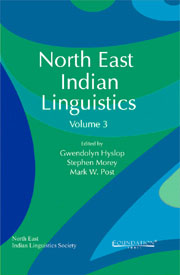Foreword
Published online by Cambridge University Press: 26 October 2011
Summary
Linguistic diversity in India
It is a fact that India is one of the most linguistically diverse countries in the world, with seven language families; namely: Indo-Aryan (of Indo-European), Dravidian, Austroasiatic, Tibeto-Burman (of Sino-Tibetan), Tai (of Tai-Kadai), Andamanese and Great Andamanese which is newly added by Abbi (2006). The North East can be described as a mini-India because there are so many different communities having various cultures and speaking various mother tongues. For example, from the Dravidian language family, particularly Tamil but also Malayalam from Kerala are spoken by inhabitants in Moreh in Manipur, a small Indo-Myanmar border trade town 109 km from Imphal. They were driven out from Mandalay in 1960 by the Burmese Army. The North East is a garden of various languages and dialects with more than one hundred various mother tongues, especially Tibeto-Burman (TB) languages – most of which are neither fully documented nor scientifically described.
Manipur has officially recognised 33 tribal languages. Besides these, Manipuri (also called Meitei) itself has six dialects, namely, Sekmai, Khurkhul, Andro, Phayeng, Koutruk and Kwatha. All these tribal languages are not yet fully and scientifically described; of these some are endangered, namely, Tarao, Monshang, Moyon, Koireng, etc. Documentation of these languages is, of course, felt to be very necessary; loss of a language goes with the loss of beliefs, culture, ecology and medicinal herbal knowledge. In Manipur there was a language called Chakpa, spoken in Andro and Phayeng; now it was extinct. Documentation was not properly done.
- Type
- Chapter
- Information
- North East Indian Linguistics , pp. ix - xviPublisher: Foundation BooksPrint publication year: 2011
- 1
- Cited by



